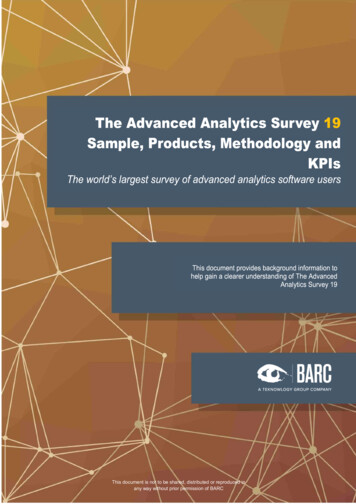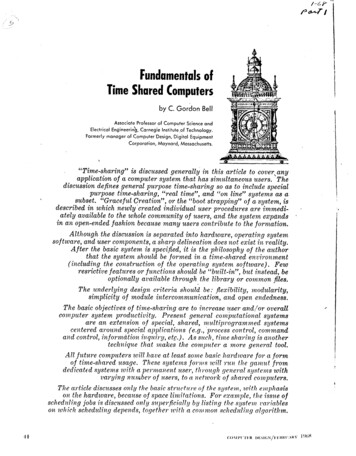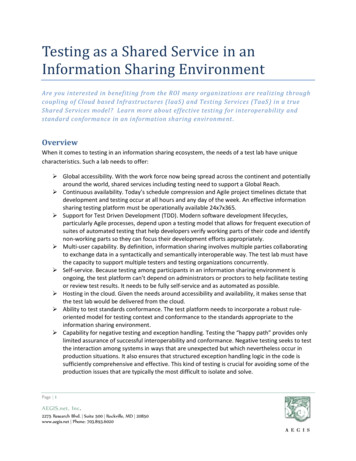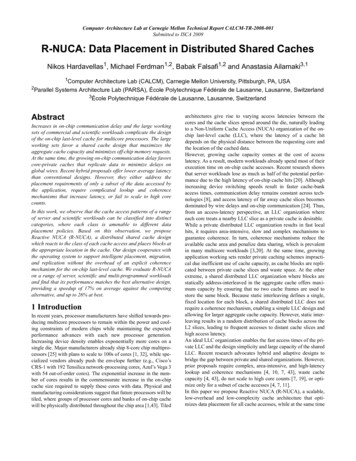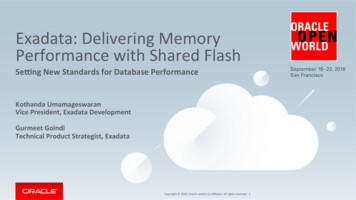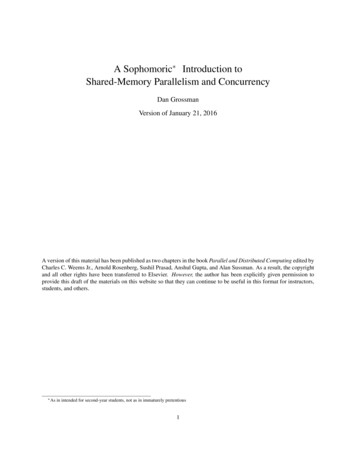
Transcription
A Sophomoric Introduction toShared-Memory Parallelism and ConcurrencyDan GrossmanVersion of January 21, 2016A version of this material has been published as two chapters in the book Parallel and Distributed Computing edited byCharles C. Weems Jr., Arnold Rosenberg, Sushil Prasad, Anshul Gupta, and Alan Sussman. As a result, the copyrightand all other rights have been transferred to Elsevier. However, the author has been explicitly given permission toprovide this draft of the materials on this website so that they can continue to be useful in this format for instructors,students, and others. Asin intended for second-year students, not as in immaturely pretentious1
Contents12Meta-Introduction: An Instructor’s View of These Notes1.1 Where This Material Fits in a Changing Curriculum . .1.2 Six Theses On A Successful Approach to this Material1.3 How to Use These Notes — And Improve Them . . . .1.4 Acknowledgments . . . . . . . . . . . . . . . . . . .33445Introduction2.1 More Than One Thing At Once . .2.2 Parallelism vs. Concurrency . . .2.3 Basic Threads and Shared Memory2.4 Other Models . . . . . . . . . . .556711Basic Fork-Join Parallelism3.1 A Simple Example: Okay Idea, Inferior Style3.2 Why Not To Use One Thread Per Processor .3.3 Divide-And-Conquer Parallelism . . . . . . .3.4 The Java ForkJoin Framework . . . . . . . .3.5 Reductions and Maps . . . . . . . . . . . . .3.6 Data Structures Besides Arrays . . . . . . . .141418202528304Analyzing Fork-Join Algorithms4.1 Work and Span . . . . . . . . . . . . . . . . . . . . . . . . . . . . . . . . . . . . . . . . . . . . . .4.2 Amdahl’s Law . . . . . . . . . . . . . . . . . . . . . . . . . . . . . . . . . . . . . . . . . . . . . . .4.3 Comparing Amdahl’s Law and Moore’s Law . . . . . . . . . . . . . . . . . . . . . . . . . . . . . . .303034365Fancier Fork-Join Algorithms: Prefix, Pack, Sort5.1 Parallel-Prefix Sum . . . . . . . . . . . . . .5.2 Pack . . . . . . . . . . . . . . . . . . . . . .5.3 Parallel Quicksort . . . . . . . . . . . . . . .5.4 Parallel Mergesort . . . . . . . . . . . . . . .3636394143Basic Shared-Memory Concurrency6.1 The Programming Model . . . .6.2 The Need for Synchronization .6.3 Locks . . . . . . . . . . . . . .6.4 Locks in Java . . . . . . . . . .44444548497Race Conditions: Bad Interleavings and Data Races7.1 Bad Interleavings: An Example with Stacks . . . . . . . . . . . . . . . . . . . . . . . . . . . . . . .7.2 Data Races: Wrong Even When They Look Right . . . . . . . . . . . . . . . . . . . . . . . . . . . .5353578Concurrency Programming Guidelines8.1 Conceptually Splitting Memory in Three Parts . . . . . . . . . . . . . . . . . . . . . . . . . . . . . .8.2 Approaches to Synchronization . . . . . . . . . . . . . . . . . . . . . . . . . . . . . . . . . . . . . .6161639Deadlock6736.10 Additional Synchronization Primitives10.1 Reader/Writer Locks . . . . . . . . . . . . . . . . . . . . . . . . . . . . . . . . . . . . . . . . . . .10.2 Condition Variables . . . . . . . . . . . . . . . . . . . . . . . . . . . . . . . . . . . . . . . . . . . .10.3 Other . . . . . . . . . . . . . . . . . . . . . . . . . . . . . . . . . . . . . . . . . . . . . . . . . . .269697176
11.1Meta-Introduction: An Instructor’s View of These NotesWhere This Material Fits in a Changing CurriculumThese notes teach parallelism and concurrency as part of an advanced sophomore-level data-structures course– the course that covers asymptotic complexity, balanced trees, hash tables, graph algorithms, sorting, etc.Why parallelism and concurrency should be taught early:Parallelism and concurrency are increasingly important topics in computer science and engineering. Traditionally,most undergraduates learned rather little about these topics and did so rather late in the curriculum: Senior-leveloperating-systems courses cover threads, scheduling, and synchronization. Early hardware courses have circuits andfunctional units with parallel parts. Advanced architecture courses discuss cache coherence. Electives might coverparallel algorithms or use distributed computing to solve embarrassingly parallel tasks.Little of this scattered material emphasizes the essential concepts of parallelism and concurrency — and certainlynot in a central place such that subsequent courses can rely on it. These days, most desktop and laptop computershave multiple cores. Modern high-level languages have threads built into them and standard libraries use threads(e.g., Java’s Swing library for GUIs). It no longer seems reasonable to bring up threads “as needed” or delay until anoperating-systems course that should be focusing on operating systems. There is no reason to introduce threads firstin C or assembly when all the usual conveniences of high-level languages for introducing core concepts apply.Why parallelism and concurrency should not be taught too early:Conversely, it is tempting to introduce threads “from day one” in introductory programming courses before students learn “sequential habits.” I suspect this approach is infeasible in most curricula. For example, it may make littlesense in programs where most students in introductory courses do not end up majoring in computer science. “Messingwith intro” is a high-risk endeavor, and introductory courses are already packed with essential concepts like variables,functions, arrays, linked structures, etc. There is probably no room.So put it in the data-structures course:There may be multiple natural places to introduce parallelism and concurrency, but I claim “sophomore-level” datastructures (after CS2 and discrete math, but before “senior-level” algorithms) works very well. Here are some reasons: There is room: We made room by removing three weeks on skew heaps, leftist heaps, binomial queues, splaytrees, disjoint-set, and network flow. Some of the trimming was painful and will be compensated for in seniorlevel algorithms, but all this material seems relatively less important. There was still plenty of room for essentialdata structures and related concepts such as asymptotic analysis, (simple) amortization, graphs, and sorting. Fork-join parallel algorithms are amenable to asymptotic analysis in terms of “work” and “span” over dags —all concepts that fit very naturally in the course. Amdahl’s Law is fundamentally an asymptotic argument too. Ideas from sequential algorithms already in the course reappear with parallelism. For example, just as constantfactors compel efficient quicksort implementations to switch to an O(n2 ) sort for small n, constant factorscompel efficient parallel algorithms to switch to sequential algorithms for small problem sizes. Parallel sortingalgorithms are also good examples of non-trivial parallelization. Many canonical examples for concurrency involve basic data structures: bounded buffers for condition variables,dictionaries for reader/writer locks, parallel unstructured graph traversals, etc. Making a data structure “threadsafe” is an ideal way to think about what it means to be “thread-safe.” We already used Java in the course. Java 7 (and higher)’s ForkJoin framework is excellent for teaching forkjoin parallelism. Java’s built-in support for threads, locks, and condition variables is sufficient for teachingconcurrency.3
On the other hand, instructors wishing to introduce message passing or distributed computation will have to considerwhether it makes sense in this course. I focus on shared memory, only mentioning other models. I do not claim sharedmemory is “better” (that’s an endless argument on which I have no firm opinion), only that it is an important modeland a good one to start with pedagogically. I also do not emphasize asynchrony and masking I/O latency. Such topicsare probably better covered in a course on systems programming, though one could add them to these notes.While most of the material is these notes is not specific to a particular programming language, all examples anddiscussions use Java when a specific language is warranted. A C version of these materials is also available thanksto Steve Wolfman from the University of British Columbia. Porting to additional languages should be quite doable,and I would be happy to collaborate with people interested in doing so.For more information on the motivation and context, see a SIGCSE2012 paper coauthored with Ruth E. Anderson.1.2Six Theses On A Successful Approach to this MaterialIn summary, these notes rest on several theses for how to teach this material:1. Integrate it into a data-structures course.2. Distinguish parallelism (using extra computational units to do more work per unit time) from concurrency(managing access to shared resources). Teach parallelism first because it is easier and helps establish a nonsequential mindset.3. Teach in a high-level language, using a library for fork-join parallelism. Teach how to use parallelism, threads,locks, etc. Do not teach how to implement them.4. Conversely, do not teach in terms of higher-order parallel patterns like maps and reduces. Mention these, buthave students actually do the divide-and-conquer underlying these patterns.5. Assume shared memory since one programming model is hard enough.6. Given the limited time and student background, do not focus on memory-hierarchy issues (e.g., caching), muchlike these issues are mentioned (e.g., with B-trees) but rarely central in data-structures courses. (Adding adiscussion should prove straightforward.)If you strongly disagree with these theses, you will probably not like these notes — but you might still try them.1.3How to Use These Notes — And Improve ThemThese notes were originally written for CSE332 at the University of s/cse332). They account for 3 weeks of a required 10-weekcourse (the University uses a quarter system). Alongside these notes are PowerPoint slides, homework assignments,and a programming project. In fact, these notes were the last aspect to be written — the first edition of the course wentgreat without them and students reported parallelism to be their favorite aspect of the course.Surely these notes have errors and explanations could be improved. Please let me know of any problems you find.I am a perfectionist: if you find a typo I would like to know. Ideally you would first check that the most recent versionof the notes does not already have the problem fixed.I encourage you to use these notes in whatever way works best for you. The LATEX sources are also available. Iwould like to know if you are using these notes and how. It motivates me to improve them and, frankly, it’s not bad formy ego. Constructive criticism is also welcome. That said, I don’t expect any thoughtful instructor to agree completelywith me on what to cover and how to cover it.Contact me at the email djg and then the at-sign and then cs.washington.edu. The current home for thesenotes and related materials is http://homes.cs.washington.edu/ djg/teachingMaterials/. Students aremore than welcome to contact me: who better to let me know where these notes could be improved.4
1.4AcknowledgmentsI deserve no credit for the material in these notes. If anything, my role was simply to distill decades of wisdom fromothers down to three weeks of core concepts and integrate the result into a data-structures course. When in doubt, Istuck with the basic and simplest topics and examples.I was particularly influenced by Guy Blelloch and Charles Leisersen in terms of teaching parallelism before concurrency and emphasizing divide-and-conquer algorithms that do not consider the number of processors. Doug Leaand other developers of Java’s ForkJoin framework provided a wonderful library that, with some hand-holding, isusable by sophomores. Larry Snyder was also an excellent resource for parallel algorithms.The treatment of shared-memory synchronization is heavily influenced by decades of operating-systems courses,but with the distinction of ignoring all issues of scheduling and synchronization implementation. Moreover, the emphasis on the need to avoid data races in high-level languages is frustratingly under-appreciated despite the noble workof memory-model experts such as Sarita Adve, Hans Boehm, and Bill Pugh.Feedback from Ruth Anderson, Kim Bruce, Kristian Lieberg, Tyler Robison, Cody Schroeder, and Martin Tompahelped improve explanations and remove typos. Tyler and Martin deserve particular mention for using these noteswhen they were very new. James Fogarty made many useful improvements to the presentation slides that accompanythese reading notes. Steve Wolfman created the C version of these notes.Nicholas Shahan created almost all the images and diagrams in these notes, which make the accompanying explanations much better.I have had enlightening and enjoyable discussions on “how to teach this stuff” with too many researchers andeducators over the last few years to list them all, but I am grateful.This work was funded in part via grants from the U.S. National Science Foundation and generous support, financialand otherwise, from Intel Labs University Collaborations.2Introduction2.1More Than One Thing At OnceIn sequential programming, one thing happens at a time. Sequential programming is what most people learn first andhow most programs are written. Probably every program you have written in Java (or a similar language) is sequential:Execution starts at the beginning of main and proceeds one assignment / call / return / arithmetic operation at a time.Removing the one-thing-at-a-time assumption complicates writing software. The multiple threads of execution(things performing computations) will somehow need to coordinate so that they can work together to complete a task— or at least not get in each other’s way while they are doing separate things. These notes cover basic concepts relatedto multithreaded programming, i.e., programs where there are multiple threads of execution. We will cover: How to create multiple threads How to write and analyze divide-and-conquer algorithms that use threads to produce results more quickly How to coordinate access to shared objects so that multiple threads using the same data do not produce thewrong answerA useful analogy is with cooking. A sequential program is like having one cook who does each step of a recipe inorder, finishing one step before starting the next. Often there are multiple steps that could be done at the same time —if you had more cooks. But having more cooks requires extra coordination. One cook may have to wait for anothercook to finish something. And there are limited resources: If you have only one oven, two cooks won’t be able to bakecasseroles at different temperatures at the same time. In short, multiple cooks present efficiency opportunities, but alsosignificantly complicate the process of producing a meal.Because multithreaded programming is so much more difficult, it is best to avoid it if you can. For most ofcomputing’s history, most programmers wrote only sequential programs. Notable exceptions were: Programmers writing programs to solve such computationally large problems that it would take years or centuries for one computer to finish. So they would use multiple computers together.5
Programmers writing systems like an operating system where a key point of the system is to handle multiplethings happening at once. For example, you can have more than one program running at a time. If you haveonly one processor, only one program can actually run at a time, but the operating system still uses threads tokeep track of all the running programs and let them take turns. If the taking turns happens fast enough (e.g., 10milliseconds), humans fall for the illusion of simultaneous execution. This is called time-slicing.Sequential programmers were lucky: since every 2 years or so computers got roughly twice as fast, most programswould get exponentially faster over time without any extra effort.Around 2005, computers stopped getting twice as fast every 2 years. To understand why requires a course incomputer architecture. In brief, increasing the clock rate (very roughly and technically inaccurately speaking, howquickly instructions execute) became infeasible without generating too much heat. Also, the relative cost of memoryaccesses can become too high for faster processors to help.Nonetheless, chip manufacturers still plan to make exponentially more powerful chips. Instead of one processorrunning faster, they will have more processors. The next computer you buy will likely have 4 processors (also calledcores) on the same chip and the number of available cores will likely double every few years.What would 256 cores be good for? Well, you can run multiple programs at once — for real, not just with timeslicing. But for an individual program to run any faster than with one core, it will need to do more than one thingat once. This is the reason that multithreaded programming is becoming more important. To be clear, multithreadedprogramming is not new. It has existed for decades and all the key concepts are just as old. Before there were multiplecores on one chip, you could use multiple chips and/or use time-slicing on one chip — and both remain important techniques today. The move to multiple cores on one chip is “just” having the effect of making multithreading somethingthat more and more software wants to do.2.2Parallelism vs. ConcurrencyThese notes are organized around a fundamental distinction between parallelism and concurrency. Unfortunately, theway we define these terms is not entirely standard, so you should not assume that everyone uses these terms as wewill. Nonetheless, most computer scientists agree that this distinction is important.Parallel programming is about using additional computational resources to produce an answer faster.As a canonical example, consider the trivial problem of summing up all the numbers in an array. We know nosequential algorithm can do better than Θ(n) time. Suppose instead we had 4 processors. Then hopefully we couldproduce the result roughly 4 times faster by having each processor add 1/4 of the elements and then we could just addthese 4 partial results together with 3 more additions. Θ(n/4) is still Θ(n), but constant factors can matter. Moreover,when designing and analyzing a parallel algorithm, we should leave the number of processors as a variable, call it P .Perhaps we can sum the elements of an array in time O(n/P ) given P processors. As we will see, in fact the bestbound under the assumptions we will make is O(log n n/P ).In terms of our cooking analogy, parallelism is about using extra cooks (or utensils or pans or whatever) to get alarge meal finished in less time. If you have a huge number of potatoes to slice, having more knives and people isreally helpful, but at some point adding more people stops helping because of all the communicating and coordinatingyou have to do: it is faster for me to slice one potato by myself than to slice it into fourths, give it to four other people,and collect the results.Concurrent programming is about correctly and efficiently controlling access by multiple threads to sharedresources.As a canonical example, suppose we have a dictionary implemented as a hashtable with operations insert,lookup, and delete. Suppose that inserting an item already in the table is supposed to update the key to map tothe newly inserted value. Implementing this data structure for sequential programs is something we assume you couldalready do correctly. Now suppose different threads use the same hashtable, potentially at the same time. Supposetwo threads even try to insert the same key at the same time. What might happen? You would have to look at yoursequential code carefully, but it is entirely possible that the same key might end up in the table twice. That is a problemsince a subsequent delete with that key might remove only one of them, leaving the key in the dictionary.6
To prevent problems like this, concurrent programs use synchronization primitives to prevent multiple threadsfrom interleaving their operations in a way that leads to incorrect results. Perhaps a simple solution in our hashtableexample is to make sure only one thread uses the table at a time, finishing an operation before another thread starts.But if the table is large, this is unnecessarily inefficient most of the time if the threads are probably accessing differentparts of the table.In terms of cooking, the shared resources could be something like an oven. It is important not to put a casserolein the oven unless the oven is empty. If the oven is not empty, we could keep checking until it is empty. In Java, youmight naively write:while(true) {if(ovenIsEmpty()) {putCasseroleInOven();break;}}Unfortunately, code like this is broken if two threads run it at the same time, which is the primary complication inconcurrent programming. They might both see an empty oven and then both put a casserole in. We will need to learnways to check the oven and put a casserole in without any other thread doing something with the oven in the meantime.Comparing Parallelism and ConcurrencyWe have emphasized here how parallel programming and concurrent programming are different. Is the problemone of using extra resources effectively or is the problem one of preventing a bad interleaving of operations fromdifferent threads? It is all-too-common for a conversation to become muddled because one person is thinking aboutparallelism while the other is thinking about concurrency.In practice, the distinction between parallelism and concurrency is not absolute. Many programs have aspects ofeach. Suppose you had a huge array of values you wanted to insert into a hash table. From the perspective of dividingup the insertions among multiple threads, this is about parallelism. From the perspective of coordinating access to thehash table, this is about concurrency. Also, parallelism does typically need some coordination: even when adding upintegers in an array we need to know when the different threads are done with their chunk of the work.We believe parallelism is an easier concept to start with than concurrency. You probably found it easier to understand how to use parallelism to add up array elements than understanding why the while-loop for checking theoven was wrong. (And if you still don’t understand the latter, don’t worry, later sections will explain similar examplesline-by-line.) So we will start with parallelism (Sections 3, 4, 5), getting comfortable with multiple things happeningat once. Then we will switch our focus to concurrency (Sections 6, 7, 8, 9, 10) and shared resources (using memoryinstead of ovens), learn many of the subtle problems that arise, and present programming guidelines to avoid them.2.3Basic Threads and Shared MemoryBefore writing any parallel or concurrent programs, we need some way to make multiple things happen at once andsome way for those different things to communicate. Put another way, your computer may have multiple cores, but allthe Java constructs you know are for sequential programs, which do only one thing at once. Before showing any Javaspecifics, we need to explain the programming model.The model we will assume is explicit threads with shared memory. A thread is itself like a running sequentialprogram, but one thread can create other threads that are part of the same program and those threads can create morethreads, etc. Two or more threads can communicate by writing and reading fields of the same objects. In other words,they share memory. This is only one model of parallel/concurrent programming, but it is the only one we will use. Thenext section briefly mentions other models that a full course on parallel/concurrent programming would likely cover.Conceptually, all the threads that have been started but not yet terminated are “running at once” in a program. Inpractice, they may not all be running at any particular moment: There may be more threads than processors. It is up to the Java implementation, with help from the underlyingoperating system, to find a way to let the threads “take turns” using the available processors. This is called7
Figure 1: The key pieces of an executing sequential program: A program counter, a call stack, and a heap of objects.(There are also static fields of classes, which we can think of as being in the heap.)scheduling and is a major topic in operating systems. All we need to know is that it is not under the Javaprogrammer’s control: you create the threads and the system schedules them. A thread may be waiting for something to happen before it continues. For example, the next section discussesthe join primitive where one thread does not continue until another thread has terminated.Let’s be more concrete about what a thread is and how threads communicate. It is helpful to start by enumeratingthe key pieces that a sequential program has while it is running (see also Figure 1):1. One call stack, where each stack frame holds the local variables for a method call that has started but not yetfinished. Calling a method pushes a new frame and returning from a method pops a frame. Call stacks are whyrecursion is not “magic.”2. One program counter. This is just a low-level name for keeping track of what statement is currently executing.In a sequential program, there is exactly one such statement.3. Static fields of classes.4. Objects. An object is created by calling new, which returns a reference to the new object. We call the memorythat holds all the objects the heap. This use of the word “heap” has nothing to do with heap data structure usedto implement priority queues. It is separate memory from the memory used for the call stack and static fields.With this overview of the sequential program state, it is much easier to understand threads:Each thread has its own call stack and program counter, but all the threads share one collection of static fieldsand objects. (See also Figure 2.)8
Figure 2: The key pieces of an executing multithreaded program: Each thread has its own program counter andcall-stack, but objects in the heap may be shared by multiple threads. (Static fields of classes are also shared by allthreads.)9
When a new thread starts running, it will have its own new call stack. It will have one frame on it, which is likethat thread’s main, but it won’t actually be main. When a thread returns from its first method, it terminates. Each thread has its own program counter and local variables, so there is no “interference” from other threads forthese things. The way loops, calls, assignments to variables, exceptions, etc. work for each thread is just likeyou learned in sequential programming and is separate for each thread. What is different is how static fields and objects work. In sequential programming we know x.f 42; y x.f; always assigns 42 to the variable y. But now the object that x refers to might also have its f field writtento by other threads, so we cannot be so sure.In practice, even though all objects could be shared among threads, most are not. In fact, just as having static fieldsis often poor style, having lots of objects shared among threads is often poor style. But we need some shared objectsbecause that is how threads communicate. If we are going to create parallel algorithms where helper threads run inparallel to compute partial answers, they need some way to communicate those partial answers back to the “main”thread. The way we will do it is to have the helper threads write to some object fields that the main thread later reads.We finish this section with some Java specifics for exactly how to create a new thread in Java. The details vary indifferent languages and in fact the parallelism portion of these notes mostly uses a different Java library with slightlydifferent specifics. In addition to creating threads, we will need other language constructs for coordinating them. Forexample, for one thread to read the result another thread wrote as its answer, the reader often needs to know the writeris done. We will present such primitives as we need them.To create a new thread in Java requires that you define a new class (step 1) and then perform two actions at run-time(steps 2–3):1. Define a subclass of java.lang.Thread and override the public method run, which takes no arguments andhas return type void. The run method will act like “main” for threads created using this class. It must take noarguments, but the example below shows how to work around this inconvenience.2. Create an instance of the class you defined in step 1. That is, if you defined class ExampleThread, then use newto create an ExampleThread object. Note this does not yet create a running thread. It just creates an object ofclass ExampleThread, which is a subclass of Thread.3. Call the start method of the object you created in step 2. This step does the “magic” creation of a new thread.That new thread will execute the run method of the object. Notice that you do not call run; that would just bean ordinary method call. You call start, which makes a new thread that runs run. The call to start “returnsimmediately” so the caller continues on, in parallel with the newly-created thread running run. The new threadterminates when
not in a central place such that subsequent courses can rely on it. These days, most desktop and laptop computers have multiple cores. Modern high-level languages have threads built into them and standard libraries use threads (e.g., Java’s Swing library for GUIs). It no longer seem
